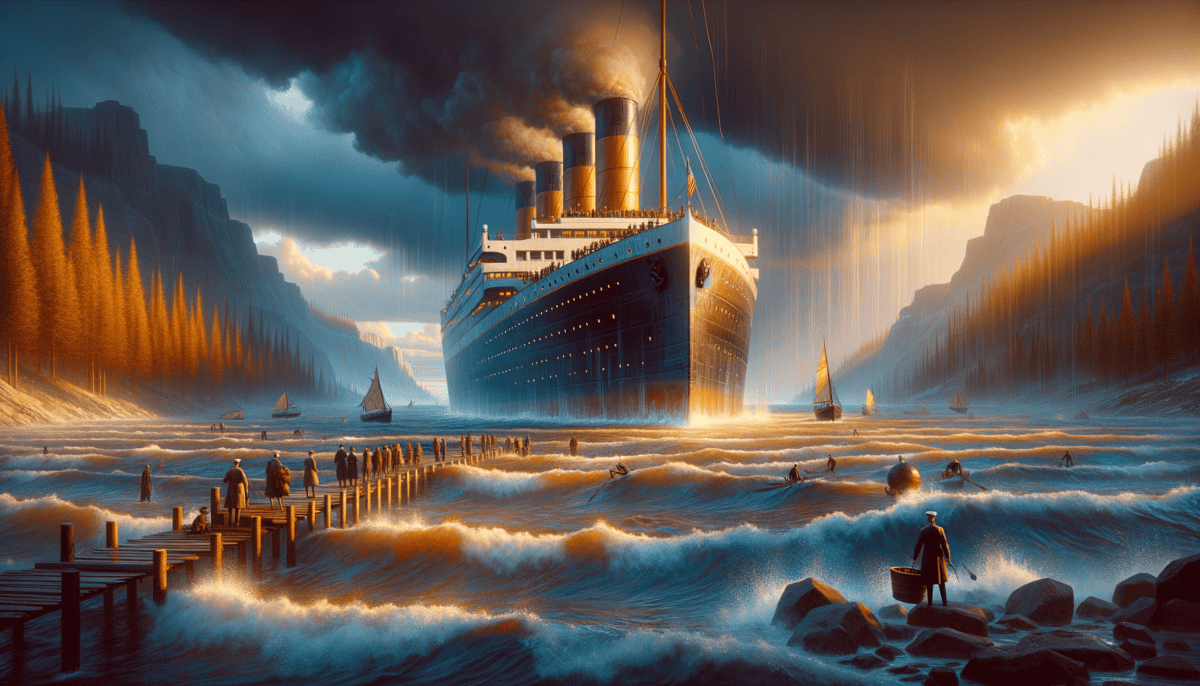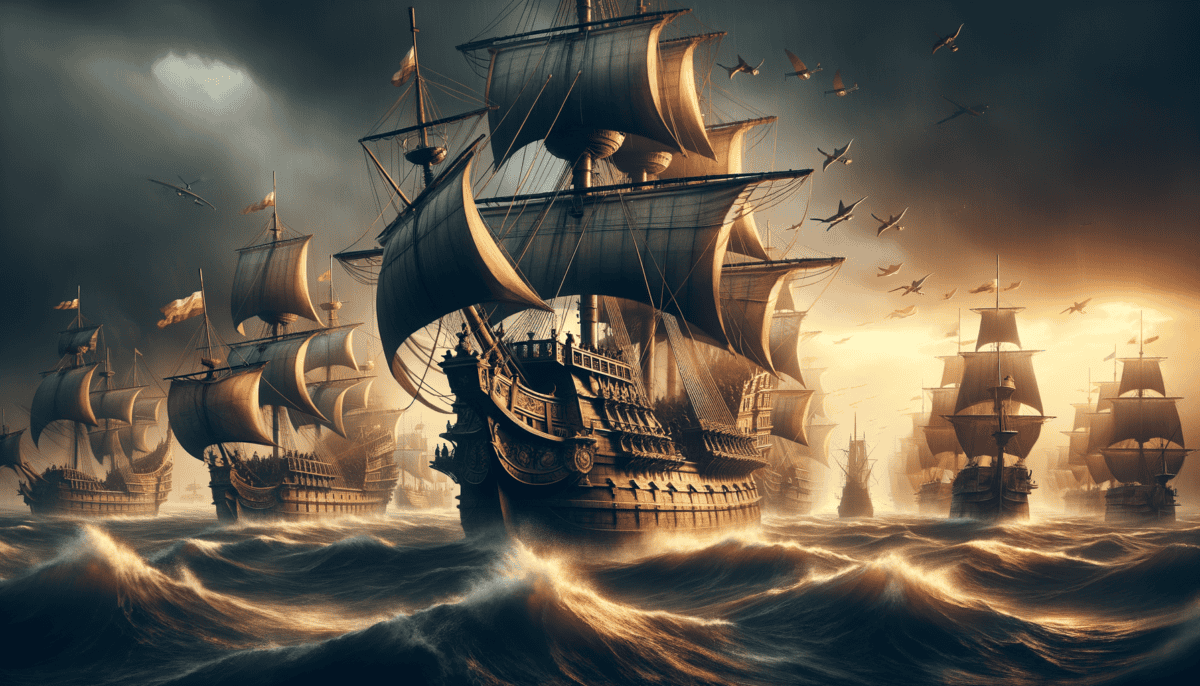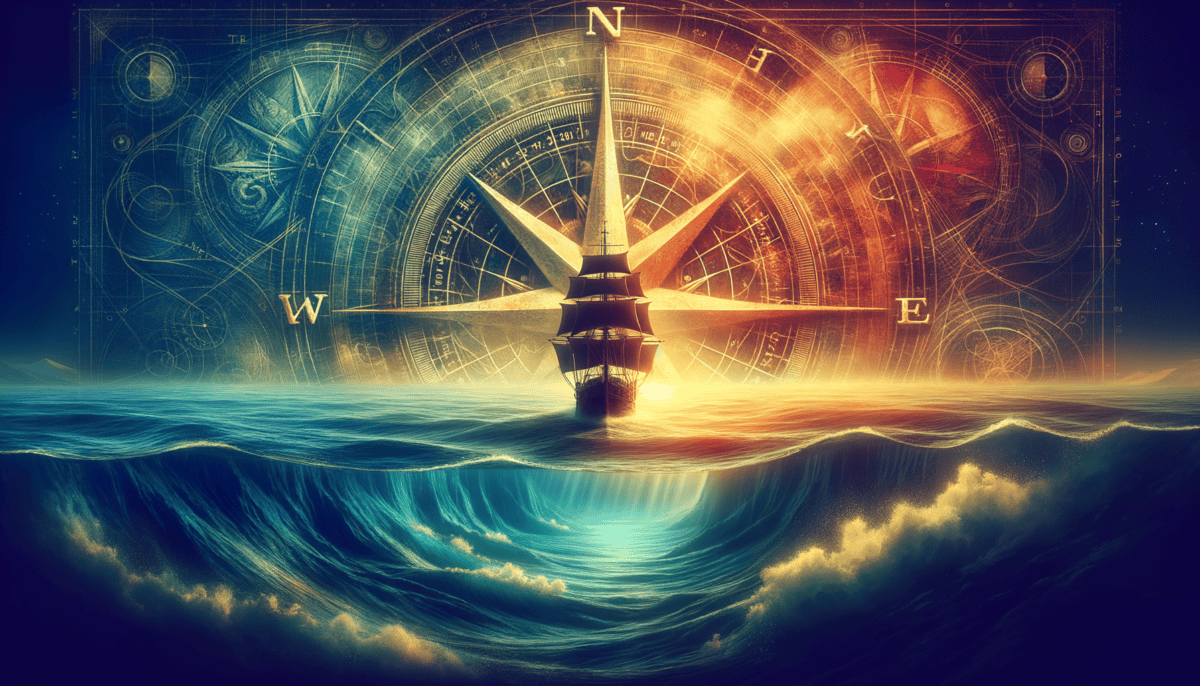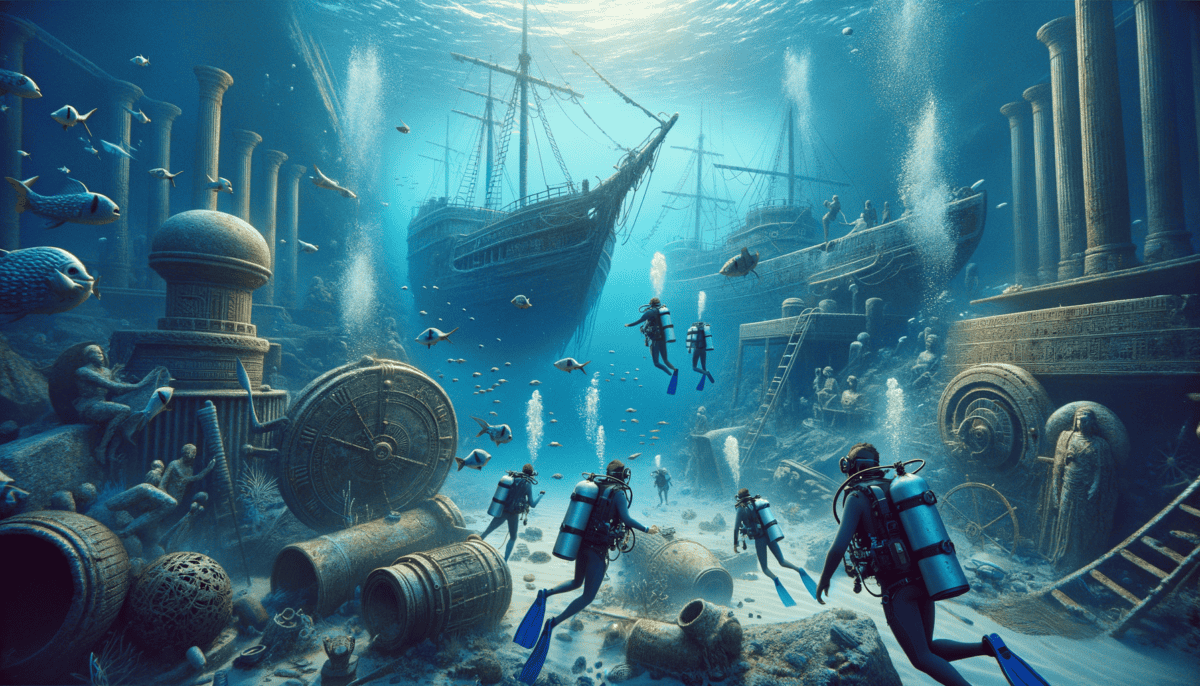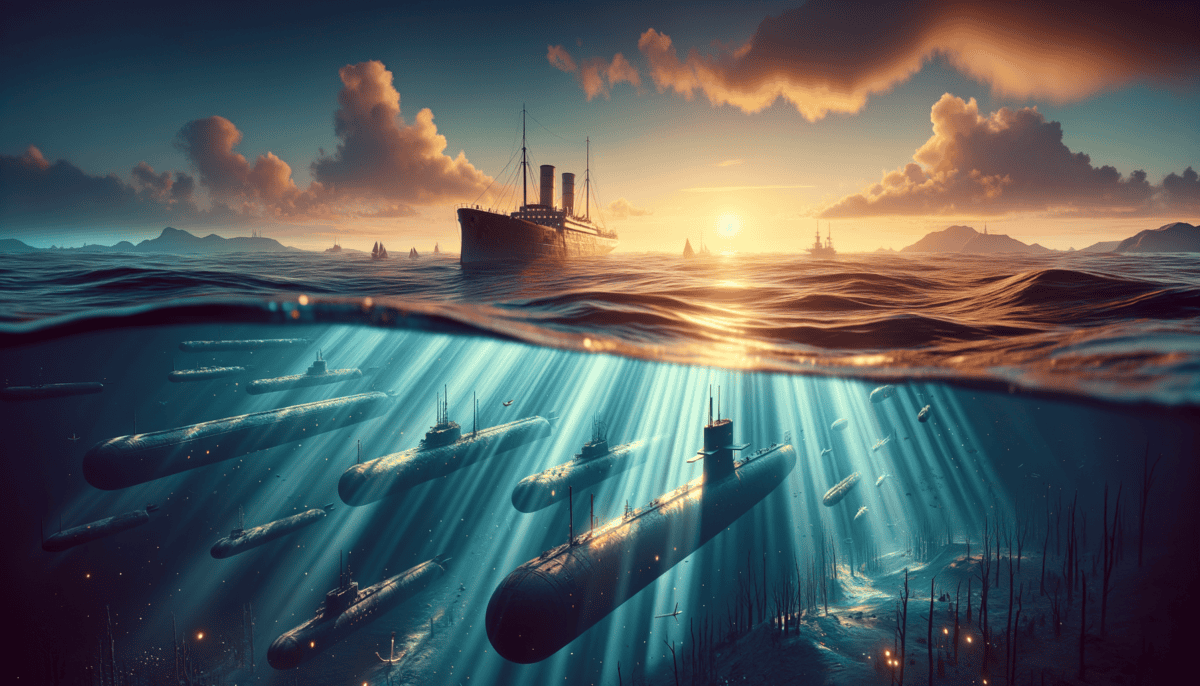The Titan’s Last Night
The massive ship gleamed under the stars. Its four giant smokestacks reached toward the sky like tall black trees. Little Sarah pressed her nose against the cold window, watching the ocean waves dance in the moonlight. ✨
"Isn't she beautiful?" Sarah's father squeezed her shoulder. "The biggest ship ever built! They say she's unsinkable."
Sarah nodded, her eyes wide with wonder. The RMS Titanic was truly a floating palace. Crystal chandeliers sparkled overhead. Rich red carpets covered the floors. The grand staircase curved like a ribbon made of warm brown wood.
"Can we explore more?" Sarah bounced on her toes. Even though it was getting late, the ship buzzed with excitement. Music floated through the halls. Ladies in sparkly dresses walked arm-in-arm with gentlemen in black suits.
"Just a little longer," her father smiled. "Then it's bedtime."
They walked past the fancy dining room where silver forks and plates gleamed. The smell of fresh bread and roasted meat made Sarah's tummy rumble. In first class, even the bathrooms had special soap that smelled like flowers!
“This ship is like a floating city,” whispered a lady in a feathered hat. “Nothing could possibly go wrong.”
But something felt strange in the air. The night was getting colder. Sarah pulled her shawl tighter. Through the window, she could see tiny ice chunks floating in the dark water.
"Papa, look!" Sarah pointed at white shapes in the distance. "Are those clouds on the water?"
Her father squinted into the darkness. "Those are icebergs, sweetheart. But don't worry – this ship is special. The captain knows what he's doing."
The ship's mighty engines hummed beneath their feet. Somewhere far above, a lookout peered into the night with his binoculars. The sea was calm, like black glass.
Sarah yawned as they headed back to their cabin. The clock showed almost midnight. As she snuggled into her warm bed, the ship's gentle rocking made her sleepy.
• The night was unusually cold
• Many ice warnings were ignored
• The ship was going too fast
• The sea was dangerously calm
"Goodnight, Papa," Sarah murmured. But something made her sit up again. Was that a shudder running through the ship? A faint scraping sound, like fingernails on a chalkboard?
Her father stood very still, listening. Far above them, voices started shouting. Running footsteps echoed down the corridors.
"What's happening?" Sarah whispered.
Her father's face looked worried in the dim light. "I'm sure it's nothing, dear. But perhaps we should get dressed… just in case."
As Sarah pulled on her warmest coat, she didn't know she was about to become part of one of history's most famous shipwrecks. The unsinkable Titanic had just met its match in the freezing Atlantic waters.
The night was young, and their adventure was only beginning. Outside their window, the dark ocean waited, hiding its secrets beneath the waves.
Whispers of the Great Lakes
The wind howled across Lake Superior like an angry wolf. Captain Ernest McSorley stood at the helm of the SS Edmund Fitzgerald, watching dark clouds gather overhead. ⛈️
“Weather’s turning nasty, Cap,” said First Mate John McCarthy. His voice was nearly lost in the growing storm.
The Edmund Fitzgerald was huge – longer than two big houses put together! Her belly was full of iron ore, heavy black rocks that made her ride low in the water. But she was strong. Everyone called her the “Pride of the Lakes.”
Captain McSorley checked his radio. Snow was falling now, thick white flakes that danced in the wind. The waves were getting bigger, taller than houses!
“This is the Fitzgerald,” he called into the radio. “Waves are really rough out here. Over.”
Another ship nearby answered back: “Same here, Fitzgerald. Stay safe out there!”
“Lake Superior never gives up her dead,” old sailors used to say. The water was too cold, too deep, too dangerous.
The giant ship rocked back and forth. Crash! A big wave hit the side. Splash! Another wave washed over the deck. The crew held on tight as the ship danced with the angry lake.
“Captain!” shouted a crew member. “The radar’s not working right!”
Captain McSorley frowned. Without radar, they were sailing blind in the storm. The snow was so thick now, they couldn’t see more than a few feet ahead. ❄️
• Giant 35-foot waves
• Heavy snowfall
• Broken radar
• Strong winds over 60 mph
The ship’s radio crackled again. “Fitzgerald, this is the Arthur Anderson. How are you holding up?”
“We are holding our own,” Captain McSorley answered. His voice was calm, but his eyes showed worry.
The wind screamed louder. The waves grew bigger. The snow fell harder. Lake Superior was turning into a monster.
Suddenly, something went wrong. The ship started to tip forward, like a seesaw. Water rushed onto the deck. The crew scrambled to keep their balance.
“May Day! May Day!” Captain McSorley grabbed the radio. But before he could say more, everything went silent.
The Arthur Anderson tried calling back. Again and again, they called. But the Edmund Fitzgerald never answered. The mighty ship had vanished into Lake Superior’s dark waters, taking all 29 crew members with her.
Years later, people still tell stories about that stormy November night. They say when the wind blows just right, you can hear the ship’s bell ringing deep under the waves, remembering the brave sailors who sailed the Great Lakes.
The Spanish Armada’s Final Battle
The mighty ships of the Spanish Armada filled the sea like a floating city. Their tall masts touched the clouds, and their flags danced in the wind.
“Look at them all!” whispered Juan, a young Spanish sailor. He had never seen so many ships in one place. The year was 1588, and Spain had sent its biggest fleet ever to fight England.
“The English ships are coming!” someone shouted. Juan could see them in the distance – smaller, faster boats that looked like water bugs next to Spain’s big galleons.
Queen Elizabeth of England stood on the shore, watching her ships sail out. She wore a shiny metal chest plate over her dress. “We shall show Spain the strength of English hearts!” she told her soldiers.
“I know I have the body of a weak and feeble woman, but I have the heart and stomach of a king!” – Queen Elizabeth I
The battle started with a boom! Cannons roared like thunder. Smoke filled the air. The smaller English ships zipped around the big Spanish ones like pesky flies.
“They’re too fast!” Juan cried. His ship, the San Martin, tried to turn to fight back. But the Spanish ships were too big and slow. They were like dancing elephants trying to catch jumping rabbits!
• Spanish ships = Big and strong
• English ships = Small and quick
• English guns could shoot farther
• Spanish ships were harder to turn
Then came the fire ships! The English set old boats on fire and sent them floating toward the Spanish fleet. The flames lit up the night sky like angry orange dragons!
“Cut the anchors!” Spanish captains shouted. “Move the ships!”
But it was too late. Many Spanish ships got tangled up trying to escape. Some crashed into each other. Others got pushed north by strong winds.
The mighty Armada was breaking apart like scattered puzzle pieces.
“We must sail around England to get home,” the Spanish admiral ordered. But the weather turned bad. Storm clouds gathered like angry giants in the sky. ⛈️
The wind howled. Rain poured down. Giant waves tossed the ships around like toys in a bathtub. Many Spanish ships crashed against rocky coasts. Others sank in the deep, cold water.
Juan held on tight as his ship fought the angry sea. “Will we make it home?” he wondered.
Only half of the Spanish ships made it back to Spain. The great Armada had failed. England had won! Queen Elizabeth danced with joy when she heard the news.
The battle changed history forever. England became the new master of the seas. But the brave sailors on both sides – English and Spanish – would always remember the great sea battle where little ships beat big ones, and nature proved stronger than them all.
Mysteries of the Devil’s Triangle
The ocean was calm as Captain Maria Rodriguez steered her research ship into the Bermuda Triangle. The sun sparkled on the water like tiny diamonds.
“Did you know ships and planes just disappear here?” asked Tommy, her 8-year-old son who was visiting the ship. His eyes were wide with wonder.
“That’s right,” Maria smiled. “We’re here to study why strange things happen in these waters.” She pointed to her computer screens showing underwater maps. ️
Just then, the ship’s instruments started beeping wildly. The compass needle spun in circles like a crazy top!
“Mom, what’s happening?” Tommy asked, grabbing her hand.
“Don’t worry, sweetie. This is exactly what we came to study. The Triangle likes to play tricks with our equipment.”
“Sometimes the simplest explanation is the right one. We just have to look closer!” – Captain Maria
Maria showed Tommy pictures of famous ships that vanished in the Triangle:
• USS Cyclops (1918) – Giant ship that disappeared without a trace
• Flight 19 (1945) – Five planes that got lost forever
• SS Marine Sulphur Queen (1963) – Big tanker that vanished
• Star Tiger and Star Ariel planes – Both gone without saying goodbye
As they looked at the pictures, the sky turned dark. Big bubbles started coming up from under the water!
“Look!” Tommy pointed. The bubbles were making the water look like it was boiling.
Maria grabbed her special camera. “This is amazing! We’re seeing methane gas bubbles. They come from the ocean floor and can make ships sink!”
The ship’s radar showed something else – weird magnetic fields under the water. They were messing up all the electronics, just like a giant magnet!
“Is this why planes get lost?” Tommy asked.
“It could be! The Triangle has lots of secrets. Some people think there are holes in time here, or alien spaceships underwater. But scientists like me look for real answers.”
Maria explained how strong storms pop up super fast in the Triangle. The Gulf Stream current can be tricky too, like a water slide that moves boats in weird ways.
That night, Tommy saw glowing circles in the water. “Ghost lights!” he gasped.
Maria laughed. “Those are bioluminescent creatures – tiny sea animals that light up like fireflies. Sailors long ago thought they were spirits!”
As they sailed on, Maria’s team found something exciting on the ocean floor – lost shipwrecks covered in coral!
“Each wreck tells a story,” Maria said. “They help us understand what really happens in the Triangle.”
The mysteries weren’t solved yet, but Maria and Tommy had seen amazing things. The Bermuda Triangle wasn’t just a spooky place – it was full of real science waiting to be discovered!
Tommy wrote in his diary: “The Triangle isn’t scary when you try to understand it. Sometimes the most mysterious things have simple answers – you just have to be brave enough to look for them!”
Secrets Under Alexandria’s Waves
Dr. Sarah Chen stood on her diving boat, looking at the sparkling waters of Alexandria’s ancient harbor. The morning sun made the Mediterranean Sea shine like blue glass.
“Today we’re going to explore a real underwater city!” she told her young assistant Maya. “It’s like finding treasure, but better – we’re finding history!”
Maya helped Dr. Chen put on her diving gear. “What do you think we’ll find down there?” she asked excitedly.
“Let’s find out!” Dr. Chen smiled, adjusting her underwater camera.
As they dove beneath the waves, an amazing sight appeared. There were huge stone columns lying on the seafloor, covered in colorful coral. Fish swam through what used to be palace doorways!
“Every stone here tells a story from long, long ago.” – Dr. Chen
Maya pointed at something sticking out of the sand. It was an old clay pot called an amphora. People used these to carry olive oil and wine thousands of years ago.
• Giant sphinx statues
• Parts of the ancient lighthouse
• Old coins and jewelry
• Pieces of wooden ships
• Stone faces of ancient kings and queens
Using special tools, Dr. Chen and her team made a map of the underwater city. They found streets, houses, and even a place where ships used to dock! ️
“Look at this!” Dr. Chen called through her diving mask. She was pointing at a big stone block with strange writing on it.
“Those are hieroglyphics,” she explained later. “They’re like ancient Egyptian emojis that tell stories!”
The divers used robots with cameras to look in places too deep or dangerous for people. The robots found pieces of an enormous statue!
“That might be from the Lighthouse of Alexandria,” Dr. Chen said. “It was one of the Seven Wonders of the Ancient World – as tall as a 40-story building!”
Back on the boat, Maya helped clean the things they found. Using gentle brushes, they removed sand and shells from old coins and broken pottery.
“We have to be very careful,” Dr. Chen explained. “These things are like pages in a history book. They tell us how people lived long ago.”
The team used computers to make 3D pictures of everything under the water. This helped them see what the city looked like before it sank!
That evening, as the sun set over Alexandria’s harbor, Dr. Chen showed Maya pictures of all their discoveries.
“The sea kept these treasures safe for hundreds of years,” she said. “Now we can learn from them and share their stories with everyone!”
Maya wrote in her notebook: “Today I touched things that ancient Egyptian kids might have used! The ocean is like a time machine – it helps us visit the past!” ⏳
Exploring Tomorrow’s Deep
Captain Maria Rodriguez stood at the controls of the Nautilus X, the world’s newest deep-sea exploration vessel. The ship’s deck buzzed with excitement as robots and diving equipment were prepared for another adventure.
“Today’s ships are so different from the old ones,” Maria told the young crew members. “We have special tools that help keep us safe!”
Tommy, the ship’s youngest explorer, watched as a robot submarine called ROV Helper splashed into the water. Its bright lights turned on, showing the way through the dark ocean.
“Look at the screen!” Tommy pointed excitedly. The robot’s cameras showed a wooden ship sitting on the ocean floor.
“This is how we learn about old shipwrecks now,” Maria explained. “The robots are like our underwater friends. They help us explore without getting wet!”
“Each shipwreck teaches us how to make sailing safer for everyone.” – Captain Maria
The team used special computers to make 3D maps of the wreck. The maps were so clear, you could count every plank of wood! ️
• Weather warning systems
• Strong life boats
• Emergency radio beacons
• Underwater radar
• Special safety training
Later that day, Maria showed Tommy the ship’s control room. Screens filled the walls, showing weather maps and ocean currents.
“See these buttons?” she smiled. “They help us talk to other ships and warn them about dangers. We work together to keep everyone safe!”
Tommy watched as colorful fish swam past ROV Helper’s cameras. “What else can we find down there?” he asked.
“The ocean is full of mysteries!” Maria laughed. “There are still so many shipwrecks to find and stories to tell.”
As the sun set, the team gathered to share their discoveries. Scientists from around the world joined their video call to learn about the wreck.
“Every time we explore,” Maria said, “we honor the brave sailors who came before us. Their stories help us build better ships and become better sailors.”
Tommy wrote in his logbook: “The ocean is like a big teacher. It shows us what went wrong in the past so we can do better in the future!”
That night, as the Nautilus X’s lights sparkled on the waves, Maria thought about all the amazing things still waiting to be discovered.
“The sea holds so many secrets,” she told Tommy. “But with science and bravery, we’re learning more every day!” ⭐
And so, the great stories of ships and sailors continue. From the mighty Titanic to the mysteries of Alexandria, each discovery helps us understand our oceans better. As long as there are curious explorers like Tommy and brave captains like Maria, the adventures will never end!
“Remember,” Maria said with a smile, “every wave holds a story, and every story makes us wiser.”


